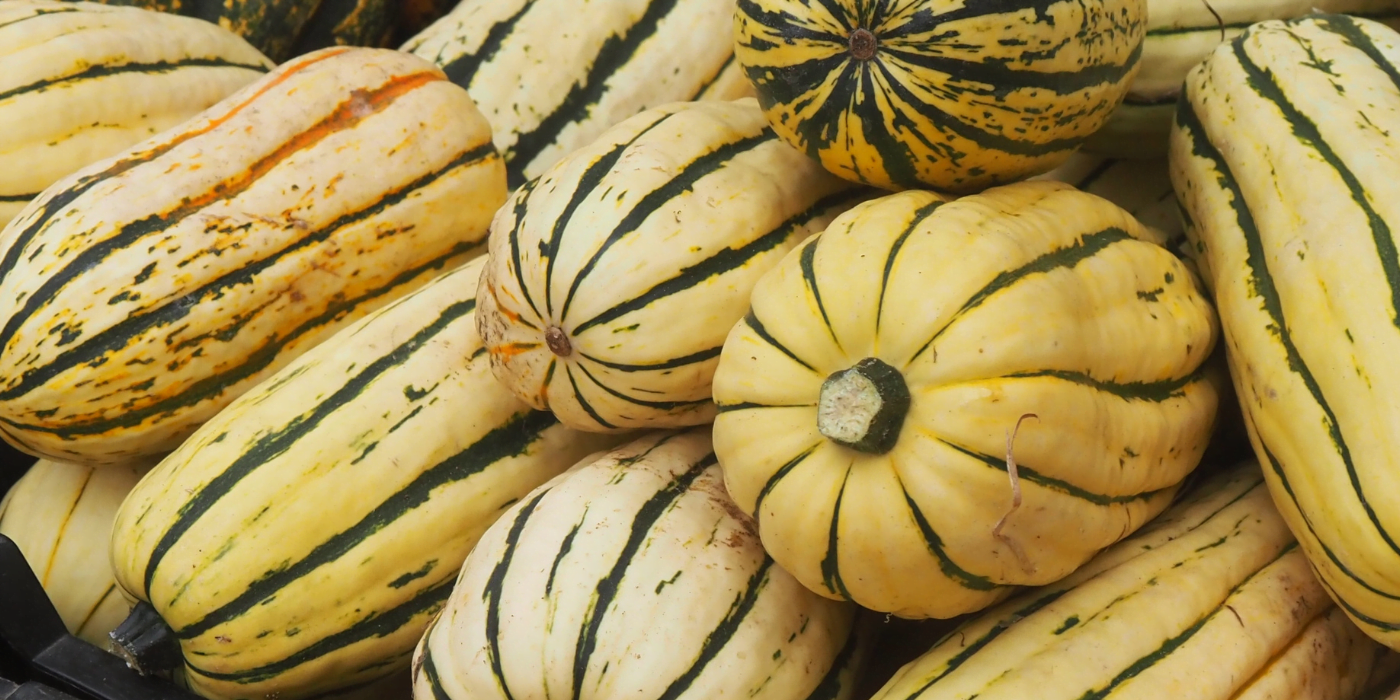As we get closer to fall with only a few weeks of summer left, winter squash are already hitting Buncombe County tailgate farmers markets. Find an array of varieties including butternut, delicata, kabocha, acorn, spaghetti, and honeynut squash. If the slightly cooler temps this week have you itching for some fall flavors, pick up some winter squash and try out these winter squash-inspired recipes. If you’re not ready to move into fall yet, fret not — summer squash and zucchini are still abundant at markets!
Butternut squash is a classic companion to fall soup. Add peeled and cubed butternut to your soup or make it shine as the star in this blended, creamy soup. Start by preheating your oven to 375 degrees and slicing your butternut squash in half, scooping out the seeds and stringy parts. Salt, pepper, and oil the inside of your squash and place it flesh side down on a sheet pan. Bake until soft, about 30 – 40 minutes. While waiting on the squash to bake, dice one onion, two cloves of garlic, and a small bunch of fresh garden sage and add them to a soup pot on medium-low heat with two tablespoons of olive oil. Stir occasionally and cook until translucent. Chop two large carrots and add to the pot along with two teaspoons of turmeric (substitute 2 inches of fresh ginger root found at the River Arts District market from Wild East Farm) and salt and pepper to taste. Add six cups of vegetable broth, bring to a boil and simmer until the carrots are tender. Once your squash is ready, remove it from the oven, flip it flesh side up to cool slightly and then scoop out the butternut into the soup pot, leaving the skin. Add one can of coconut milk and using a blender in batches or an immersion blender, puree the soup until creamy. Serve in bowls and garnish with your favorite fresh herbs like cilantro or parsley.
Because of their thin skin, delicata squash make a quick and easy side dish. Since you can eat the skin, there is no need to peel these fall beauties. Start by preheating your oven to 425 degrees. Cut off the ends of the delicata then cut it in half lengthwise, scooping out the seeds and stringy parts. Cut the halves into slices and place them on a sheet pan. Drizzle with olive oil, salt, pepper, and any spices of choice. Transfer to the oven and bake until golden brown, about 20-25 minutes. Pair these with chicken, mix them into a kale salad with cubed apple and pepitas, or top them onto rice.
In addition to the typical medley of winter squash, you may even find a special heirloom variety adapted to this region — the candy roaster! As first cultivated by the Cherokee people in the 1800s and kept alive today through seed saving and careful open-pollinated growing by the Eastern Band of Cherokee Indians, this cultivar is a native wonder. Candy roasters, also known as North Georgia candy roasters, pink bananas, and jumbo pink bananas store well through the winter, sweetening with time and have a sweet potato like flavor. Their skin colors range from a pink to tan or orange with some hints of green and blue. Their plants and leaves are very large and some variants can grow up to 200 lbs! Use them like butternut squash or make them into a delicious pumpkin pie. The first candy roasters were spotted last week at Flying Cloud Farm at the North Asheville and River Arts District markets.
Also spotted at markets in recent weeks: pawpaws, tomatoes, sweet and hot peppers, cucumbers, okra, beets, cabbage, carrots, kohlrabi, green beans, kale, mushrooms, eggplant, okra, potatoes, onions, scallions, peaches, plums, nectarines, melons, early apples, muscadines, Asian pears, sweet corn and fresh herbs. Markets offer an abundance of farm-fresh eggs and meats, including chicken, pork, beef, and lamb. You can also get bread, cheese, pastries, fermented products, drinks, and prepared foods. Find more details about farms and markets throughout the region, including hours and location, in ASAP’s online Local Food Guide.

